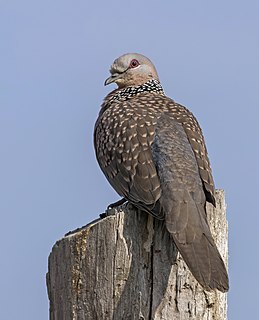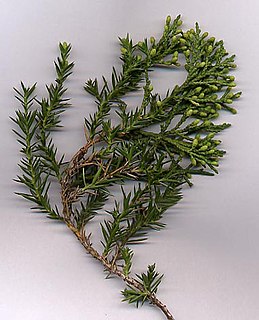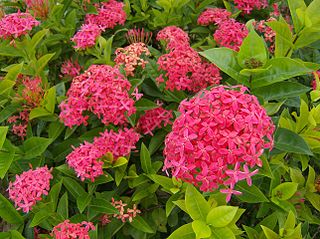
Lychee is the sole member of the genus Litchi in the soapberry family, Sapindaceae.

Jojoba, with the botanical name Simmondsia chinensis, and also known as goat nut,deer nut,pignut,wild hazel,quinine nut,coffeeberry, and gray box bush, is native to the Southwestern United States. Simmondsia chinensis is the sole species of the family Simmondsiaceae, placed in the order Caryophyllales.

The spotted dove is a small and somewhat long-tailed pigeon that is a common resident breeding bird across its native range on the Indian subcontinent and in Southeast Asia. The species has been introduced to many parts of the world and feral populations have become established.

Chinese cabbage can refer to two cultivar groups of Chinese leaf vegetables often used in Chinese cuisine: the Pekinensis Group and the Chinensis Group.

Bok choy, pak choi, or pok choi is a type of Chinese cabbage. Chinensis varieties do not form heads and have green leaf blades with lighter bulbous bottoms instead, forming a cluster reminiscent of mustard greens. Chinensis varieties are popular in southern China and Southeast Asia. Being winter-hardy, they are increasingly grown in Northern Europe. Now considered a subspecies of Brassica rapa, this group was originally classified as its own species under the name Brassica chinensis by Carl Linnaeus. They are a member of the family of Brassicaceae or Cruciferae, also commonly known as the mustards, the crucifers, or the cabbage family.

Juniperus chinensis, the Chinese juniper is a species of plant in the cypress family Cupressaceae, native to China, Taiwan, Myanmar, Japan, Korea and the Russian Far East. Growing 1–20 m (3.3–65.6 ft) tall, it is a very variable coniferous evergreen tree or shrub,

Schisandra chinensis, whose fruit is called magnolia berry or five-flavor-fruit, is a deciduous woody vine native to forests of Northern China and the Russian Far East. It is hardy in USDA Zone 4. The plant likes some shade with moist, well-drained soil. The species itself is dioecious, thus flowers on a female plant will only produce fruit when fertilized with pollen from a male plant. However, a hybrid selection titled 'Eastern Prince' has perfect flowers and is self-fertile. Seedlings of 'Eastern Prince' are sometimes sold under the same name, but are typically single-sex plants. The fruits are red berries borne in dense hanging clusters around 10 cm long.

The Central Mountain Range is the principal mountain range on Taiwan Island. It runs from the north of the island to the south. Due to this separation, connecting between the west and east is not very convenient. The tallest peak of the range is Xiuguluan Mountain, 3,860 m (12,664 ft).

Ixora is a genus of flowering plants in the family Rubiaceae. It is the only genus in the tribe Ixoreae. It consists of tropical evergreen trees and shrubs and holds around 562 species. Though native to the tropical and subtropical areas throughout the world, its centre of diversity is in Tropical Asia. Ixora also grows commonly in subtropical climates in the United States, such as Florida where it is commonly known as West Indian Jasmine. Other common names include viruchi, rangan, kheme, ponna, chann tanea, techi, pan, siantan, jarum-jarum/jejarum, jungle flame, jungle geranium, cruz de Malta among others. The plants possess leathery leaves, ranging from 3 to 6 inches in length, and produce large clusters of tiny flowers in the summer. Members of Ixora prefer acidic soil, and are suitable choices for bonsai. It is also a popular choice for hedges in parts of South East Asia. In tropical climates they flower year round and are commonly used in Hindu worship, as well as in ayurveda and Indian folk medicine.

Rosa chinensis, known commonly as the China rose or Chinese rose, alternatively known as Bengal rose or Bengal Crimson or Bengal Beauty is a member of the genus Rosa native to Southwest China in Guizhou, Hubei, and Sichuan Provinces. The first publication of Rosa chinensis was in 1768 by Nikolaus Joseph von Jacquin in Observationum Botanicarum, 3, p. 7, p. 55.

Neolamarckia cadamba, with English common names burflower-tree, laran, and Leichhardt pine, and called kadam locally, is an evergreen, tropical tree native to South and Southeast Asia. The genus name honours French naturalist Jean-Baptiste Lamarck. It has scented orange flowers in dense globe-shaped clusters. The flowers are used in perfumes. The tree is grown as an ornamental plant and for timber and paper-making. Kadam features in Indian religions and mythologies.
Pratt's vole is a species of rodent in the family Cricetidae. It is endemic to Mount Emei, Sichuan, China. It was named in 1891 for Antwerp Edgar Pratt.

Astilbe chinensis, commonly known as false goat's beard, tall false-buck's-beard or Chinese astilbe, is a plant in the saxifrage family, Saxifragaceae. It is commonly grown in shade gardens.

Tectorigenin is an O-methylated isoflavone, a type of flavonoid. It can be isolated from leopard lily, in Iris unguicularis or Pueraria thunbergiana.

Iris domestica, commonly known as leopard lily, blackberry lily, and leopard flower, is an ornamental plant in the family Iridaceae. In 2005, based on molecular DNA sequence evidence, Belamcanda chinensis, the sole species in the genus Belamcanda, was transferred to the genus Iris and renamed Iris domestica. Other synonyms are Epidendrum domesticum L., Vanilla domestica (L.) Druce, Belamcanda punctata Moench, Gemmingia chinensis (L.) Kuntze, Ixia chinensis L., Morea chinensis, and Pardanthus chinensis Ker Gawl.)

Rhus chinensis, the Chinese sumac, or nutgall tree, is a plant species in the genus Rhus.

Sophronica is a genus of longhorn beetles of the subfamily Lamiinae, containing the following species:
Sophronica bimaculipennis is a species of beetle in the family Cerambycidae. It was described by Stephan von Breuning in 1955, originally under the genus Sophronisca. It is known from Ghana, the Ivory Coast, and Guinea. It contains the varietas Sophronica bimaculipennis var. besnardi.
Sophronica rufulescens is a species of beetle in the family Cerambycidae. It was described by Stephan von Breuning in 1940. It feeds on the Monterey Pine.
Sophronica grisea is a species of beetle in the family Cerambycidae. It was described by Per Olof Christopher Aurivillius in 1908.















